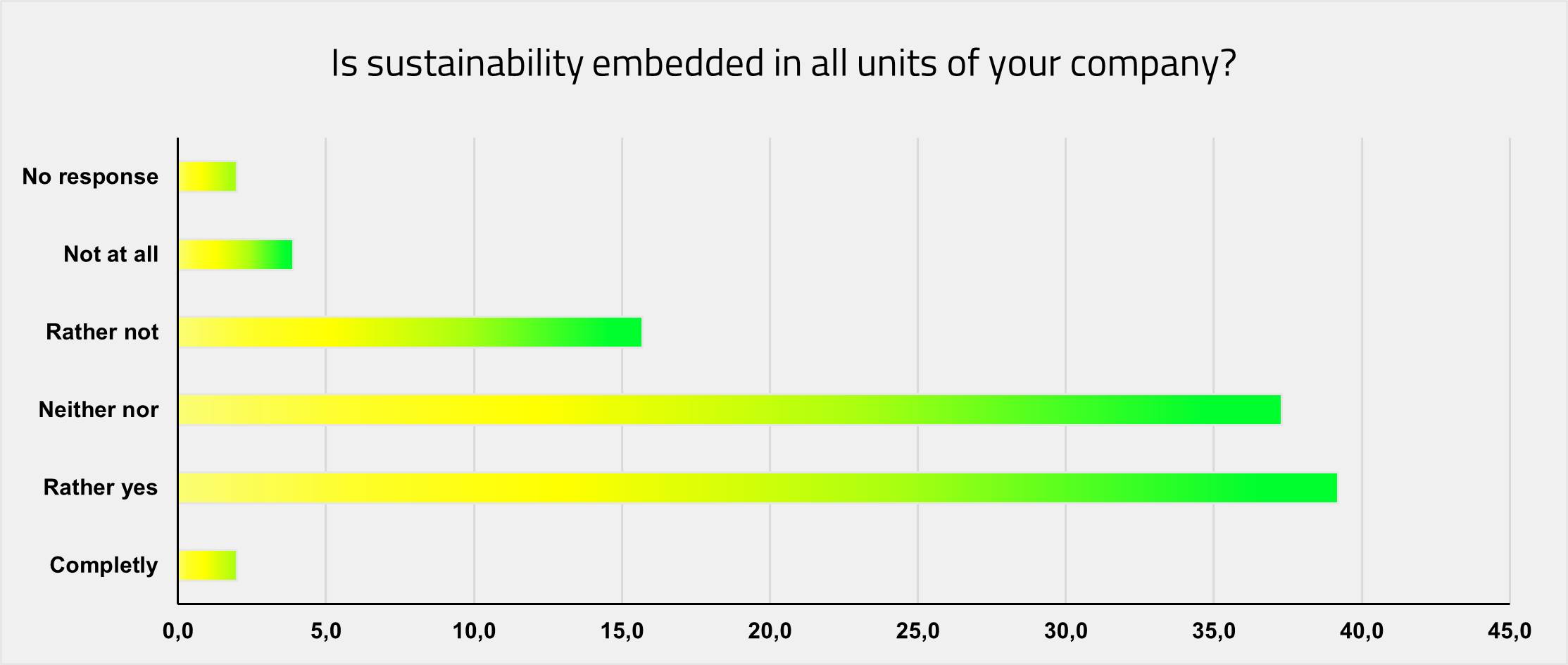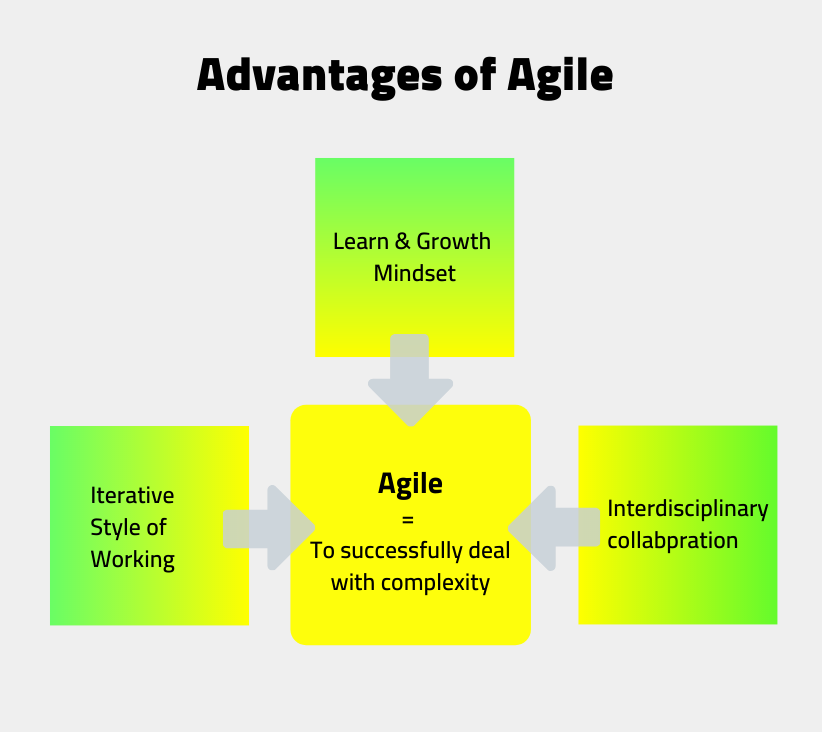Sustainability Transformation? Asap!
Companies are under increasing pressure to become more transparent about their environmental and climate impact. The EU taxonomy further increases this pressure and uses the financial markets as a central lever by ensuring that sustainability risks are included in the assessment of investments. For sustainability risks to be assessed, the transparency mentioned above is needed: The EU’s CSRD will make non-financial reporting mandatory for significantly more companies. Thus, it becomes strategically relevant for companies to reduce sustainability risks if they want to maintain their access to capital at favourable conditions. The German Supply Chain Act and its due diligence obligation directly applies to larger companies, but indirectly also affects small and medium-sized enterprises if they are part of the larger companies’ supply chains. Additionally, in B2C businesses, we can observe a change in customer preferences: three-quarters of consumers pay attention to the sustainability of products they buy. Almost half have been spending more money on sustainable products since the start of the corona pandemic (McKinsey 2021). The urgency and importance of sustainability transformation for companies is therefore clear. Now they must act – asap.
For companies, the first step is to evaluate which regulatory requirements, business customers’ and consumers’ sustainability needs are relevant for them. This includes weighing up the possible reporting standards that can be met over and above legal requirements, as these differ considerably in some cases. In a second step, companies should measure and evaluate how they are currently performing and incorporate the results into their reporting. In addition, strategic sustainability goals should be derived from this first performance measurement to align the company on the right development track.
Once the company's sustainability goals have been formulated, it is time to implement them. To achieve the goals, it is essential to involve the employees. Various studies show that:
- Employee participation improves important outcomes such as efficient resource use, waste and emissions reduction (Florida & Davidson 2001, May & Flannery 1995, Denton 1999).
- Industries with the greatest sustainability efforts also exhibited the most extensive forms of employee participation (Markey et al. 2016).
- The more employees participate in the strategic integration of sustainability efforts, the better companies can exploit the "green competitive advantage" (Brio & Junquera 2007, Iraldo et al. 2017, Wee & Quasi 2005).
Actively engaging employees in the strategic implementation of sustainability goals means tapping into their tacit knowledge (Boiral 2002, Rothenberg 2003), empowering them to make suggestions for improvement (Denton 1999, Kitazawa & Sarkis 200), and fostering an organizational culture conducive to sustainability improvements (Kitazawa & Sarkis 2000, Stone 2000).
Sustainability transformation is therefore not only a technical challenge, but also explicitly a cultural and organizational one.
This becomes quite obvious when sustainability managers are preparing a CSR report, and one of their biggest hurdles is to be after their colleagues in order to obtain relevant and high-quality data. When sustainability is not anchored as a lived value and concrete goal for employees, sustainability managers are all too often lone wolves. The Sustainability Management Monitor 2021 confirms this picture: Only 2 percent of the companies stated that sustainability was fully anchored in all areas.

Graphic: Own illustration based on Kunzlmann, Edinger-Schons & Kraemer (2021).
However, transformation cannot be achieved as a lone warrior. If sustainability is not reflected in corporate strategy, management style (connecting of strategy with everyday corporate life) as well as culture and processes, it is considerably more difficult to achieve sustainability goals. To successfully implement their own sustainability transformation, companies should therefore openly and honestly ask themselves, "How are we currently doing this at our company? And how do we want to do it?"
When answering the second question, the agile tool set can be of great value. The development and use of agile methods began in the 1990s in the context of software development. The technological possibilities, framework conditions and needs of customers evolved so quickly that software was no longer relevant at the time of its release. Sustainability transformation, while a different challenge, has similar characteristics.

Graphic: Own illustration.
- Agility helps companies deal with complex challenges such as sustainability transformation.
Working in an agile way means working iteratively: Testing ideas and solution approaches, evaluating the findings, and further developing ideas and solutions based on them. This way of working enables us to act in a complex, ambiguous and rapidly evolving environment and to move forward step by step. In addition, adaptability is maintained because there is no solution that has been planned and is meant to be implemented consistently and according to plan. In times of major upheavals such as the sustainability transformation, which is characterized by constant changes in the environment - whether regulatory, physical or market-related - such adaptability and an organizational ability to learn are of the utmost importance for entrepreneurial success.
- Employee participation means collaboration - agile working methods explicitly support this.
Agile working methods rely on interdisciplinary collaboration so that they can achieve the speed and adaptability mentioned above. They create processes, structures, and culture for this purpose, in other words, the right framework conditions. As explained above, the participation of employees is central to successfully achieve sustainability goals. It is precisely this interdisciplinary collaboration across departmental boundaries that is needed. Otherwise, employees' contributions, ideas and suggestions for improvement cannot be used effectively - or they do not materialize at all because they do not understand what their personal contribution to the sustainability transformation can look like.
Based on these insights, we at The Morph Company have developed the asap Agile Sustainability Approach. It makes agile tools usable for the sustainability transformation:

Graphic: Own illustration.
The asap Agile Sustainability Approach focuses on two dimensions: internal and external. On the inside, the aim is to effectively implement the company's sustainability strategy (strategy) and to involve employees in achieving the strategic sustainability goals through agile working methods (culture). One of the concrete tools for the internal dimension are sustainability OKRs, an agile target management system that generates ownership for the achievement of sustainability targets and promotes cross-departmental collaboration.
Externally, the aim is to involve customers in the sustainability transformation. By this, we do not mean marketing measures, but the added value that companies offer their customers - through their products and services, their core business. To remain relevant on the market, companies must specifically incorporate customer needs and sustainability goals into product and service innovation (innovation). The motto is "active instead of reactive." And agile working methods are extremely helpful for this. Methods from design thinking such as user research, personas or customer journeys help to understand what the changing needs of customers look like, to quickly develop ideas based and to concretize these through tests with the target group (need-solution-fit). To understand whether the idea in question can successfully be placed on the market, it is important to understand the market potential through trend analyses on the one hand and, on the other, to check the market suitability through rapid testing, for example with the help of the lean start-up approach (product-market fit). At the same time, the sustainability goals that the company has set for itself must be incorporated into product and business model development. This can be done, for example, using methods such as Circular Thinking or the Sustainable Business Model Canvas (Product-Sustainability-Fit). Innovation projects can be designed within the company, but also in the sense of open innovation together with strategic partners from the company's ecosystem.
In summary, it is important for companies to act now - not only to react to regulatory, physical and market-related changes, but to also integrate them strategically at an early stage and thus secure competitive advantages. For companies to remain adaptable and to be able to take both employees and customers along with it, the asap Agile Sustainability Approach makes the agile tool set available for sustainability transformation.
——-
Bibliography
- Boiral, O. (2002): Tacit Knowledge and Environmental Management. Long Range Planning,, 3535(3): 291–317. https://doi.org/10.1016/s0024-6301(02)00047-x
- Brio, J. A. del, Fernandez, E. & Junquera, B. (2007): Management and employee involvement in achieving an environmental action-based competitive advantage: an empirical study. International Journal of Human Resource Management, 18(4): 491–522. https://doi.org/10.1080/09585190601178687
- Denton, D. (1999): Employee involvement, pollution control and pieces to the puzzle. Environmental Management and Health, 10(2): 105–111. https://doi.org/10.1108/09566169910259769
- Florida, R.; Davison, D. (2001): Gaining from green management: environmental management systems inside and outside of the factory. California Management Review, 43:. 64–84. https://doi.org/10.2307/41166089
- Iraldo, F., Testa, F., Lanzini, P., & Battaglia, M. (2017): Greening competitiveness for hotels and restaurants. Journal of Small Business and Enterprise Development, 24(3): 607–628. https://doi.org/10.1108/jsbed-12-2016-0211
- Kitazawa, S. & Sarkis, J. (2000): The relationship between ISO 14001 and continuous source reduction programs. International Journal of Operations & Production Management, 20(2): 225–248. https://doi.org/10.1108/01443570010304279
- Kunzlmann, J., Edinger-Schons, L.M. & Kraemer, A. (2021): Sustainability Management Monitor. Gütersloh: Bertelsmann Stiftung. Online: https://www.bertelsmann-stiftung.de/de/publikationen/publikation/did/sustainability-monitor-all
- Markey, R.,; McIvor, J. & Wright, C. (2016): Employee participation and carbon emissions reduction in Australian workplaces. International Journal of Human Resource Management, 27(2): 173–191. https://doi.org/10.1080/09585192.2015.1045009
- May, D. R., & Flannery, B. L. (1995): Cutting waste with employee involvement teams. Business Horizons, 38(5): 28–38. https://doi.org/10.1016/0007-6813(95)90033-0
- McKinsey (2021): Corona-Pandemie verstärkt den Trend zu nachhaltigem Konsum. Online: https://www.mckinsey.com/de/news/presse/2021-05-17-pm-nachhaltiger-konsum?cid=eml-web
- Rothenberg, S. (2003): Knowledge Content and Worker Participation in Environmental Management at NUMMI. Journal of Management Studies, 40(7): 1783–1802. https://doi.org/10.1111/1467-6486.00400
- Stone, L. (2000). When case studies are not enough: the influence of corporate culture and employee attitudes on the success of cleaner production initiatives. Journal of Cleaner Production, 8(5): 353–359. https://doi.org/10.1016/s0959-6526(00)00037-8
- Wee, Y. S., & Quazi, H. A. (2005): Development and validation of critical factors of environmental management. Industrial Management & Data Systems, 105(1): 96–114. https://doi.org/10.1108/02635570510575216

Kommentare